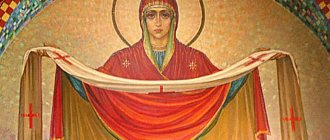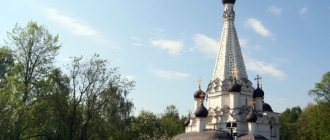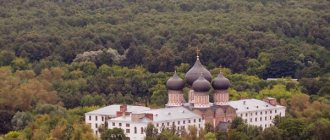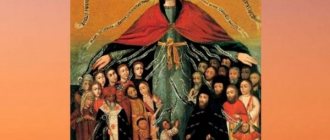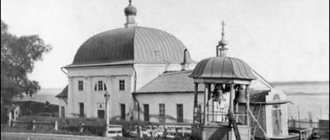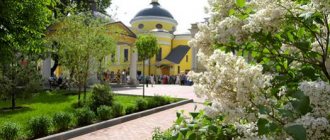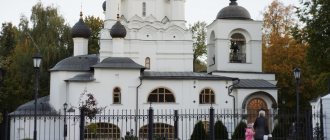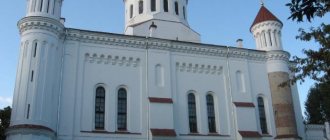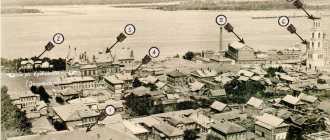On October 14, all Orthodox believers celebrate the Feast of the Intercession. Despite the fact that this holiday is not even the twentieth, it is nevertheless very significant and beloved among the people. Like many other holidays dedicated to the Queen of Heaven. After all, since ancient times it was with her that the Russian people pinned their hopes for salvation in such critical situations when it seemed that there was nothing left to hope for. As the last hope, they turned to her with a prayer for help when the Russian land needed protection from enemies. And about support in difficult life situations, when there is not enough strength to deal with adversity. It is precisely this seemingly hopeless situation that is told in the story to which the holiday of Intercession is dedicated.
The history of the church holiday of the Intercession
The events preceding the appearance of this holiday, revered in Russia, took place in distant Constantinople in 910. The city was under siege. Exhausted residents gathered in the Blachernae temple to pray to the Lord for the liberation of Constantinople from the Saracens. At this time, the blessed holy fool Andrew came to the church with his disciple Epiphanius, the future patriarch of Constantinople. In the Blachernae Church there was a robe of the Mother of God, Her belt and veil.
The whole night was spent in fervent prayer, and in the morning Saint Andrew saw the Mother of God praying over the believers along with the angels, accompanied by the Apostle John the Theologian and the Prophet John the Baptist. The Queen of Heaven shone brighter than the sun. The Mother of God knelt down at the altar and tearfully prayed for a long time for the salvation of Christians. Having prayed, the Mother of God took off her veil, sparkling like lightning, from her head and spread it over the believers.
Blessed Andrew and Epiphanius watched the miracle taking place with reverent awe, until the Mother of God became invisible. After this memorable service, the enemies retreated from the walls of Constantinople, and the day of the appearance of the Queen of Heaven in the Blachernae Church served as the beginning of the celebration of the Protection of the Mother of God in the Russian Orthodox Church.
For almost a thousand years, this holiday was celebrated only in Russia. In Greece, where the memorable event took place, it was forgotten. The celebration of the Intercession in the Greek Church began in the 20th century.
The Holy Synod decided to hold a solemn service on October 28, according to the new style - October 14.
Description and meaning in Orthodoxy
In Rus', this holiday appeared in the 12th century during the reign of Prince Andrei Bogolyubsky. Then the Volga Bulgars attacked North-Eastern Rus'. The inhabitants of Suzdal, Vladimir and Murom suffered from their raids. For the war with the Bulgars, Prince Andrei called soldiers from neighboring lands under his banner.
The miraculous icons of the All-Merciful Savior and the Mother of God of Vladimir were taken on the campaign. With holy intercession, the Russian squad quickly defeated the Bulgars. The prince's army was almost unharmed, and he saw this as a real miracle.
Returning home, Saint Andrei Bogolyubsky, by his decree, approved a new Orthodox holiday in honor of the Intercession of the Most Holy Theotokos. It means that the Queen of Heaven protects us with her prayer cover.
The Orthodox Church recommends spending the Day of the Intercession of the Most Holy Mother of God in prayer
The Orthodox Church recommends dedicating the great Christian holiday of the Intercession of the Most Holy Theotokos to prayer. The fact is that the Intercession itself is the day of protection of people by the Mother of God. The fact is that She is merciful and intercessor for them before the Lord. If you pray to her on Her day, she can provide significant help to the person praying.
Video: Prayer for the Intercession of the Blessed Virgin Mary Sofia Nikulina Orthodox music. At 27 seconds the author begins to pray to the Most Holy Theotokos on her Intercession.
Typically, prayer for the Intercession of the Most Holy Theotokos helps in the following cases:
- escape from danger;
- healing the sick;
- message of a gentle winter and protection of winter crops;
- protection from disasters, both natural and public;
- about a roof over their heads for those who do not have one;
- assistance in material well-being and the provision of daily bread;
- assistance in marriage and improving family relationships.
Sample text of a prayer for the Day of the Intercession of the Most Holy Mother of God:
Oh, Most Holy Virgin, Mother of the Lord of the highest powers, Queen of heaven and earth, our city and country, Almighty Intercessor! Accept this singing of praise and gratitude from us, unworthy Thy servants, and lift up our prayers to the Throne of God Thy Son, that He may be merciful to our iniquities, and add His grace to those who honor Thy all-honorable name and with faith and love worship Thy miraculous image. We are not worthy of being pardoned by Him, unless You propitiate Him for us, the Lady, for everything is possible for You from Him. For this reason, we resort to You, as to our undoubted and speedy Intercessor: hear us praying to You, cover us with Your all-powerful protection, and ask God for Your Son: zeal and vigilance for our souls as our shepherds, wisdom and strength as city rulers, truth and impartiality for judges , the mentor is reason and humility, the spouse is love and harmony, the child is obedience, the offended is patience, the fear of God is offended, the sorrowful is complacency, the rejoicing is abstinence; for all of us is the spirit of reason and piety, the spirit of mercy and meekness, the spirit of purity and truth.
To her, Most Holy Lady, have mercy on Your weak people; Gather those who are scattered, guide those who have gone astray to the right path, support old age, raise young ones to be chaste, raise infants, and look upon us all with the gaze of Your merciful intercession, raise us from the depths of sin and enlighten our heartfelt eyes to the vision of salvation, be merciful to us here and there, in the land of earthly arrival and at the terrible judgment of Your Son; Having ceased in faith and repentance from this life, our fathers and brethren began to live with the Angels and all the saints in eternal life.
For you are, Lady, the Glory of heaven and the Hope of earth, You, according to God, are our Hope and Intercessor of all who flow to You with faith. We therefore pray to You, and to You, as the Almighty Helper, we commit ourselves and each other and our whole life, now and ever and unto ages of ages. Amen".
By leaving a comment, you accept the user agreement
Orthodox celebration traditions
The Russian Orthodox Church considers the Most Holy Theotokos to be its main patroness. She tirelessly asks Her Son and Our Lord for the salvation of living and departed Christians.
Every year on October 14, all Orthodox churches hold festive services in honor of the Intercession of the Most Holy Theotokos. On this day, believers strive to visit churches and pray to the Queen of Heaven, ask for help or give thanks.
The Icon of the Intercession of the Mother of God is prayed to for various needs. She responds to the sincere requests of believers to grant healing from illnesses and solve material and housing problems. They ask the Mother of God to protect peace and tranquility in the family, the girls pray for a speedy marriage and a happy marriage.
Orthodox people believed that the presence of the icon of the Intercession of the Most Holy Theotokos in the house would protect the home from fire. The peasants prayed in front of the holy image for a rich harvest and good weather.
Prayers
Any believer can always count on the intercession of the Most Holy Mother of God, but on the Feast of the Intercession it takes on a special meaning.
Any believer can always count on the intercession of the Most Holy Mother of God, but on the Feast of the Intercession it takes on a special meaning. What are they praying for on this day:
- to be healed;
- return prosperity to the family;
- protect from harm;
- improve your financial situation;
- get married;
- get rid of bad weather (for those involved in agriculture) and give a rich harvest;
- strengthen your faith and resist temptations.
You can read prayers for the Intercession not only on the eve of the holiday, but also on any day.
- Troparion, tone 4
Today, people of good faith brightly celebrate, overshadowed by Your coming, O Mother of God, and, looking at Your most pure image, we tenderly say: cover us with Your honorable cover and deliver us from all evil, begging Your Son, Christ our God, to save our souls.
- Kontakion, tone 3
The Virgin stands today in the Church, and from the faces of the saints she invisibly prays to God for us: the angels and the bishops bow down, the apostles and the prophets rejoice: for for our sake the Mother of God prays to the Eternal God
- Greatness
We magnify You, Most Holy Virgin, and honor Your honest Protection, for Saint Andrew saw You in the air, praying for us to Christ.
Iconography
The most ancient images of the Intercession, which were preserved on the Golden Suzdal Gate. The image of the Mother of God here is depicted in profile, and an omophorion extends over her. The images on the icons of the Intercession of the Mother of God are based on the biography of Blessed Andrei the Fool, from whom everyone learned about the appearance of the Mother of God. There are two traditions of icon painting:
- “Suzdal” - on these icons the Mother of God, extending her omophorion over those praying, is depicted in front of the temple, which represents the outline of the Blachernae Church, where the miraculous phenomenon took place.
- “Novgorod” - here the Mother of God is depicted praying in the temple together with other believers. She stands on a cloud above the closed Royal Doors. A red cover is spread over the Mother of God, which is carefully held on both sides by angels floating in the air.
Suzdal iconography is associated with the first Bogolyubskaya icon of the Mother of God. It was from it that lists of miraculous icons were made, which were distributed to numerous churches in Russia. The earliest surviving Novgorod icon of the Intercession of the Virgin Mary is an image from the ancient Zverin Monastery. The composition of the icon is symmetrical. The images of its parts are balanced. In the center is the image of the Mother of God, to the right and left are the participants in the great event.
Later, these two traditions of depicting the great event began to unite. Starting from the 17th century, the composition of icons changed. They depict the solemn procession of the Mother of God, accompanied by saints and angels to the Throne of the Savior.
Russian icon painters reverently and carefully depicted not only important details from chronicle sources, but also images of saints. On the icons of the Intercession of the Virgin Mary, the Apostle John the Theologian and the Prophet John the Baptist are always present. They are located to the left of the image of the Mother of God. On the right you can see Andrei the Fool, pointing out a miraculous vision to his student Epiphanius.
There are revered icons in honor of the Feast of the Intercession of the Virgin Mary in many urban and rural churches.
Temples in Rus'
The first church dedicated to the Feast of the Intercession of the Most Holy Theotokos was erected by Andrei Bogolyubsky himself. The monument of ancient Russian architecture was erected at the confluence of the Nerl and Klyazma rivers in the Vladimir region. It rises in the middle of a huge meadow on a man-made hill, which becomes a small island in the spring when the water in the rivers rises.
After the victorious capture of Kazan, Tsar Ivan the Terrible ordered the foundation of the Intercession Cathedral, which later became St. Basil's Cathedral. In the autumn of 1554, a temporary wooden temple was built. The stone cathedral was built over the course of 6 years, and until 1600 it was the tallest building in Moscow.
Many churches were consecrated in honor of the Intercession of the Virgin Mary. The most famous is the Intercession Cathedral at the Rogozhskoye cemetery, built at the end of the 18th century. It was conceived as a five-domed temple of quite impressive size, but, by order of Empress Catherine II, the project was changed. As a result, the cathedral was left with one chapter, and the height of the building was reduced. Until the Cathedral of Christ the Savior was restored, the Intercession Cathedral was considered the largest Moscow church.
The holiday is also highly revered by the Old Believer Church. The holiday of the Intercession is one of the most revered in Russia. Almost every city has temples and cathedrals consecrated in his honor. In Moscow alone there are about a hundred of them.
Historical sources
The event of the appearance of the Mother of God is described in the life of Andrei the Fool, the years of whose life were established only tentatively. More than 110 Greek manuscripts have survived to this day, containing different editions of the life, the oldest of which may date back to the second half of the 10th century. According to his life, the saint lived during the time of Emperor Leo the Great (the Wise). In the version described in the collection of lives of saints of the 16th century, “The Great Fourth Menaion,” neither the day of the week nor the date is indicated; it only says that the vision occurred during the all-night vigil in the Blachernae Church. Bishop Dimitri of Rostov, who lived at the end of the 17th century, described that the vision occurred on Sunday.
Different sources provide different information about who the Byzantine Empire was at war with in those years. According to one version - with the Muslim Saransk, according to another - with the tribes of the Rus or Bulgarians.
Opinions also differ about the origin of the holiday. Various versions have been expressed about the place of his appearance. According to one of them, he came from Byzantium, according to another, the Intercession is of Russian origin. The question of where it appeared remains open.
The Feast of the Intercession of the Blessed Virgin Mary became especially revered in Rus' back in the pre-Mongol period. The Russian church teaching collection “Prologue” of the 12th century contains a mention of the establishment of its celebration, and the tradition of the Russian Church considers the holy fool Andrew to be a Slav who lived in Constantinople. Some of the most famous Russian churches are dedicated to the Feast of the Intercession - the Church of the Intercession on the Nerl, built in the 12th century by Prince Andrei Bogolyubsky, and the Cathedral of the Intercession on the Moat, better known as St. Basil's Cathedral.
Divine service
Chants dedicated to the Intercession are included in all ancient Russian stichirari. This holiday was first mentioned in Prologues and collections of instructive texts from the late 12th – early 13th centuries. The Intercession began to be celebrated throughout Rus' only in the 15th century. The Great Menaions, compiled by Saint Macarius, Metropolitan of Moscow, contain words of praise for the Feast of the Intercession of the Theotokos.
All church hymns dedicated to the holiday are imbued with a feeling of gratitude and joy. The Mother of God is the great intercessor of the Russian people before the Lord. Her holy prayers protect Orthodox people from misfortunes and evil. In the festive troparion, believers ask the Mother of God to cover everyone with her honest cover and pray to God for the salvation of souls.
Folk traditions and signs
Mid-October in Rus' was considered a transition period from autumn to winter. By this time, the peasants were trying to finish all field work, prepare livestock for the winter, and stockpile food. The harsh frosty season had already begun. The stoves began to burn, the huts were carefully caulked.
On the day of the Intercession, the last sheaf, the “reaper,” was given to the cattle. It was prepared by the whole family and stored until the holiday in the front corner of the hut. It was believed that this sheaf would protect animals from harm and give them strength to survive the harsh winter.
The Feast of the Intercession of the Virgin Mary is a favorable time for weddings. As the popular saying goes: “Pokrov-holiday, cover the earth with snow, and my head with a crown.” Every young girl dreamed of getting married at this time. After all, the Mother of God herself was the patroness on this significant day. They prayed to her and lit candles in front of her icon in churches. It was believed that the girl who was the first to light a candle to the Virgin Mary would be the first to get married.
“Pokrovsky” day is rich in folk signs. The peasants determined by it. What kind of winter will it be? The first snow, which fell on October 14, foreshadowed the early onset of winter. And vice versa, it will be soft and snowless if rain falls on the Pokrov. The flight of cranes to warmer regions on this day is a sure sign of an early and cold winter.
Maple and birch trees have not lost their leaves by mid-October - expect severe frosts. The upcoming winter weather was also determined using a weather vane. Wind from the north - cold winter, from the south - warm. Frost on Pokrov has a symbolic meaning. It covers the earth, just as the Most Holy Theotokos protects all Orthodox Christians with her omophorion.
On Intercession Day you cannot work, quarrel, drink alcohol, or handle money.
In connection with the celebration of the Intercession of the Day, folk custom established many prohibitions. So, for example, you cannot clean the house on Pokrov, or do household chores. It is also forbidden to quarrel or judge anyone on this day.
You shouldn't drink alcohol either. In addition, folk wisdom does not recommend borrowing or borrowing money on Pokrov. It is believed that by doing this you can give away your luck and happiness, and take away the sorrows and problems of another person.
"Celebration of the wedding contract." Shibanov Mikhail. 1777 Tretyakov Gallery. Moscow. In Rus' it was believed that an unmarried girl should not refuse the man who was wooing her.
In Rus' there was an opinion that a girl who was wooed on that day should not have been refused. The fact is that it was believed that in this case the Mother of God could punish her. In this case, she will have to spend a whole year alone. For the same reason, it was not recommended to swear on Pokrov.
